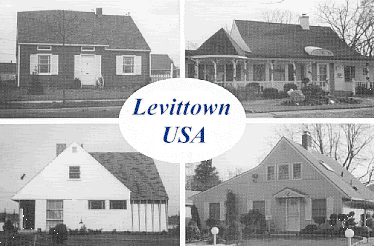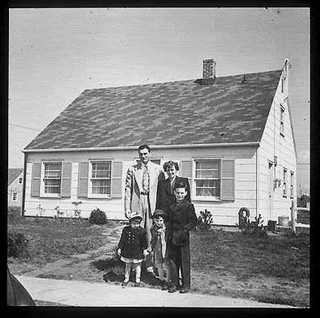

Few communities in America are as easily recognizable by name as Levittown, New York. In addition to its distinction as the childhood home of world famous singer/songwriter, Billy Joel, (who was actually raised in a Levitt home in nearby Hicksville) Levittown is the model on which scores of post World War II suburban communities were based - a place that started out as an experiment in low-cost, mass-produced housing and became, perhaps, the most famous suburban development in the world.
The story of Levittown begins with the story of the Hempstead Plains, sixty thousand acres of flat, treeless grasslands that was once considered the largest prairie in the eastern United States. It was here, in 1644, that a group of English colonists established Hempstead, the first permanent settlement in what later became Nassau County. Subsequently, through various grants and land deals, Hempstead was divided into territories, one of which became known as Island Trees, likely because it contained a tall group of pine trees that, from a distance, resembled an island unto itself.
The few early residents of Island Trees were mainly farmers of English descent. When the Long Island Rail Road extended its tracks from Jamaica to Hicksville in 1836, the Island Trees farmers found themselves with a new, more convenient means of transporting their goods to market - and for receiving shipments of feed and fertilizer. This made the area surrounding Hicksville highly attractive to German land developers, who soon purchased large parcels of land in the railroad's vicinity, which included Island Trees.
Over the next several decades, small villages of immigrants, most from Germany, sprouted up around the area. Island Trees' main cash crops in the late 1800s were cabbage and cucumbers, until a severe blight hit the area in 1912 and farmers shifted their attention to potato farming. Island Trees soon became the center of potato farming in Nassau County. But then, in the mid 1930s, farmers in the area suddenly began to experience serious potato crop damage brought on by a dreaded critter called the Golden Nematode. It was at the onset of this crisis that Abraham Levitt and his sons, Alfred and William, purchased an abandoned potato field in Island Trees at a "greatly reduced price."
Levitt & Sons
Abraham Levitt was a real estate lawyer by trade, but also dabbled in real estate investment, purchasing land and selling it off to developers in the late 1920s. When the onset of the 1930's Great Depression caused the developer of a Rockville Centre property to default on his payments, the senior Levitt was forced to complete the development himself to protect his investment. Having no previous experience with construction, he called on his two sons, in college at the time, for help. Together, Levitt & Sons labored to learn everything there was to know about construction techniques, and together, they completed the project.
Strathmore, as the upscale Rockville Centre development was named, was such a success that Levitt and Sons continued to purchase land and build new homes throughout the Depression. With each new development, their construction methods became more and more efficient.
When the U.S. entered WWII in 1941, Levitt and Sons won a Navy contract to build homes for shipyard workers in Norfolk, Virginia. Here, they developed and perfected the mass production techniques they later used in the construction of Levittown, New York. It may have also been this experience that inspired William, the older of the Levitt sons, to enlist in the Navy in 1943.
Meanwhile, back home in Island Trees, the golden nematode had gained a strong foothold and was wiping out a large part of the area's potato crop, on which many local farmers depended for survival. By 1945 and the end of World War II, Island Trees farmers began looking to sell off affected land as quickly as they could.
At the same time, 16 million GI's were returning from either Europe, the Pacific, or from military bases in the United States. Many planned to marry and raise families. But these former soldiers were running into trouble in their search to find suitable shelter for their new families. The war had created a shortage of construction materials and the housing industry had fallen off rapidly. At the end of 1945, the US was in dire need of about five million houses, as ex-GIs and their families were living with their parents or in rented attics, basements, or unheated summer bungalows. Some even lived in barns, trolley cars, and tool sheds.
During his service in Hawaii, Lieutenant William Levitt realized that the urgent need for post-war housing and the availability of cheap farmland provided a golden opportunity for his family to capitalize on their Island Trees property. He proposed to his father and brother that Levitt & Sons divide the former potato field into small lots and build simple, inexpensive mass-produced homes for veterans and their families. These returning servicemen were entitled to low-interest, insured "GI Loans," which would make the new Levitt homes easily affordable and, therefore, highly attractive.
The Birth Of Levittown
On May 7, 1947, Levitt and Sons publicly announced their plan to build 2,000 mass-produced rental homes for veterans on their Island Trees land. Two days later, the New York Herald Tribune reported that 1,000 of the 2,000 proposed homes had already been rented. Levittown, as the new development would eventually be named, was off to a booming start!
In order to build their homes cheaper and faster, Levitt and Sons decided to eliminate basements and build their new homes on concrete slabs, as they had in Norfolk, Virginia. This practice was prohibited in the Town Of Hempstead, but, because the need for housing was so urgent, the Town modified the Building Code to allow the Levitts to proceed with their plan.
Levitt and Sons used many of the building methods they had used over the years in previous developments, but reorganized these methods for even better efficiency and cost savings. All of the lumber was precut and shipped from a lumber yard they owned in Blue Lake, California, where they erected a nail factory as well. An abandoned rail line was re-opened to bring construction materials to Island Trees. To keep costs down, non-union contractors were used, a move met with heavy opposition. The production line technique used to build this new development was so successful that, by July of 1948, the Levitts were turning out thirty houses a day.
Even at this pace, the Levitts could not keep up with the demand. Although all 2,000 homes had been rented almost immediately, hundreds of veterans were still applying, so the Levitts decided to build an additional 4,000 houses. The community soon had its own schools, its own postal delivery; even phone service and streetlights!
Then, in 1949, Levitt and Sons discontinued building rental houses and turned their attention to building larger, more modern houses, which they called "ranches" and which they would offer for sale at $7,990. All a prospective buyer needed was a $90 deposit and payments of $58 per month. The Levitt ranch measured 32' by 25' and came in five different models, differing only by exterior color, roof line, and the placement of windows. Like previous Levitt homes, the ranch was built on a concrete slab with radiant heating coils. It had no garage, and came with an expandable attic. The kitchen was outfitted with a General Electric stove and refrigerator, stainless steel sink and cabinets, the latest Bendix washer, and a York oil burner. Immediately, the demand for the new Levitt ranches was so overwhelming that even the procedure for purchasing them had to be modified to incorporate "assembly line" methods. Once these techniques were put into action, a buyer could choose a house and sign a contract for it within three minutes.
As the GI homeowners settled into well-paying jobs and began to spawn families, the Levitt models and the surrounding community were modified to suit the needs of growing families. 1950 ranches came with a carport and a 12 1/2 inch Admiral TV set built into the living room staircase. The 1951 model included a partially finished attic. Thousand Lanes, a magazine devoted to the decorating, expanding, and remodeling of Levitt homes became a must-have for Levittown residents. Shopping centers, playgrounds, and a $250,000 community center sprang up to accommodate Levittown's active residents. The July, 1951 issue of the Nassau Daily Review Star reported that "Levittown's fame has spread so widely, both in America and abroad that it now ranks near the Statue of Liberty among the seven wonders which New York City visitors want to see!"
By the time the last Levitt and Sons house was purchased in 1951, Abraham, Alfred, and William had earned the distinction of having completed the largest housing development ever constructed by a single builder.



1 comment:
Great story. Who wrote it?
Diggin' the blog, by the way!
Travis
www.travisjensensf.com
Post a Comment